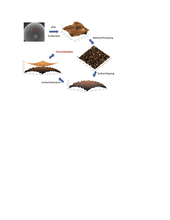Highlight
A predictive framework for the cohesion reduction of fine pharmaceutical powders via surface modification
Achievement/Results
In this project, a team of IGERT (Integrative Graduate Education and Research Traineeship) research students working with Prof. Rajesh Dave of New Jersey Institute of Technology have investigated how use of less than 1 % amount of nano-particles (size smaller than 20 nanometers, which is 2000 times smaller than diameter of human hair), uniformly decorated on the surface of very small pharmaceutical particles (bout the size of human hair or finer) can lead to dramatic improvements in several important properties or characteristics of those powders and can lead to significant cost savings and improvements of pharmaceutical drug products such as tablets and capsules. Their work funded by two separate NSF awards, IGERT: DGE-0504497 and ERC: EEC-0540855, involves use of cutting-edge instruments, development of new, patented processing and characterization devices, and developing models that can explain the experimental results helping develop simple guidelines for industrial practice. The work is highly interdisciplinary in nature, requiring use of expertise and knowledge from both engineering (mechanical as well as chemical) and sciences (chemistry, physics, and pharmaceutics).
The main topic of this work, flow and handling of fine powders, is of great interest to pharmaceutical industry. High cohesion (tendency to stick amongst themselves and having difficulty in flowing like in confectioners sugar) observed in fine pharmaceutical powders leads to problems such as, poor flowability, electrostatic charging, powder?s sticking tendency, formation large chunks or agglomerates, and low bulk density that leads to larger volume needed for processing and transport. These also lead to downstream problems such as poor content uniformity, marginal improvement in dissolution rate of fine API powders, and need for extra processing steps such as granulation. While the usual practice is to mitigate such flow problems via use of flow-aids and glidants, our work, which is dry coating based surface modification, is a more rigorous approach due to its ability to achieve precise surface coating of nano-silica and other flow-aides; making it very popular in recent academic research as well in industrial applications.
The students in this project have achieved results using several devices, both based on batch and scalable continuous operation, for pharmaceutically relevant powders where the surface coating includes not only silica but also several types of “guest” materials. Dry coating devices they have used or developed are categorized in two approaches; the first approach is suitable for powders in 150 down to 10 micron sizes where attrition or breaking down of powder size is minimal. In the second approach, suitable for even finer particles, including those used in the inhaler application having aerodynamic diameters in the size range of 2 ~ 5 microns, simultaneous micronization and surface modification is considered. Results of the bulk properties for these powders have been obtained and illustrate the improvement in flow, fluidization, dispersion, lack of agglomeration, bulk density, and electrostatic tendency, all leading to potentially significant cost benefits in industrial processing, handling, storage and transportation.
In addition, the students have jointly worked on developing contact modeling, starting from classical Rumpf single asperity model to their own advanced models where the influence of material properties, surface area coverage and spatial and size distribution of guest particles is considered. They have also developed a simplified modeling approach, depicted in the graphical picture, that allows for predicting the bulk performance that require only small quantities of powders. In that approach, powders that are surface modified via attaching nano-particles or other materials on their surface are scanned using Atomic Force Microscopy (AFM) to quanitify their surface roughness which is typically of the order of 10 to 100 nanometers. Based on the surface scan, a statistically equivalent surface having spherical bumps is created, and mapped on to a larger diameter sphere equal to the original pharmaceutical powder. Such particle is mechanically deformed in a computer simulation by pressing against a smooth sphere and then through classical mechanics models, the pull-off force is computed. At least 500 such statistically equivalent contacts are simulated to develop a frequency distribution of inter-particle pull-off force, providing a very realistic picture of how these surface modified particles would attract each other. This allows for predictive design of improved powders. These efforts have also help propose a 2-D phase-map based on key bulk powder properties to help make manufacturing decisions regarding the formulation strategy for solid pharmaceutical dosages.
Address Goals
This activity addresses the primary goal of discovery by uncovering the nanoscale mechanisms of particle interactions and improvement in desired properties, giving us predictive capability to build better pharmaceutical products. This activity enhances learning and training of students due to engaging of high school teachers, their students, as well as undergraduate students, interactions with faculty members and postdoctoral research associates from several universities and of diverse disciplines, and exposure to international research (internships done in UK, Spain, and Germany).






